Audit Technology: Assessing Impact and Adoption Strategies for Firms
VerifiedAdded on 2022/09/15
|10
|2209
|16
Report
AI Summary
This report examines recent advancements in audit technology and their implications for audit firms and auditors. It addresses concerns about the impact of technology on the auditor's role, communication within audit teams, and the future of analytical procedures. The report highlights key digital trends such as data analytics, blockchain, and audit support systems, emphasizing their potential to enhance risk assessment, improve data accessibility, and reduce bias in decision-making. It also discusses the importance of human auditors in interpreting data and maintaining stakeholder relationships. The report concludes by recommending the adoption of data analytics for firms currently using traditional auditing methods, citing benefits such as reduced costs, improved reliability, and enhanced communication. This document is available on Desklib, where students can find a wealth of resources, including past papers and solved assignments.
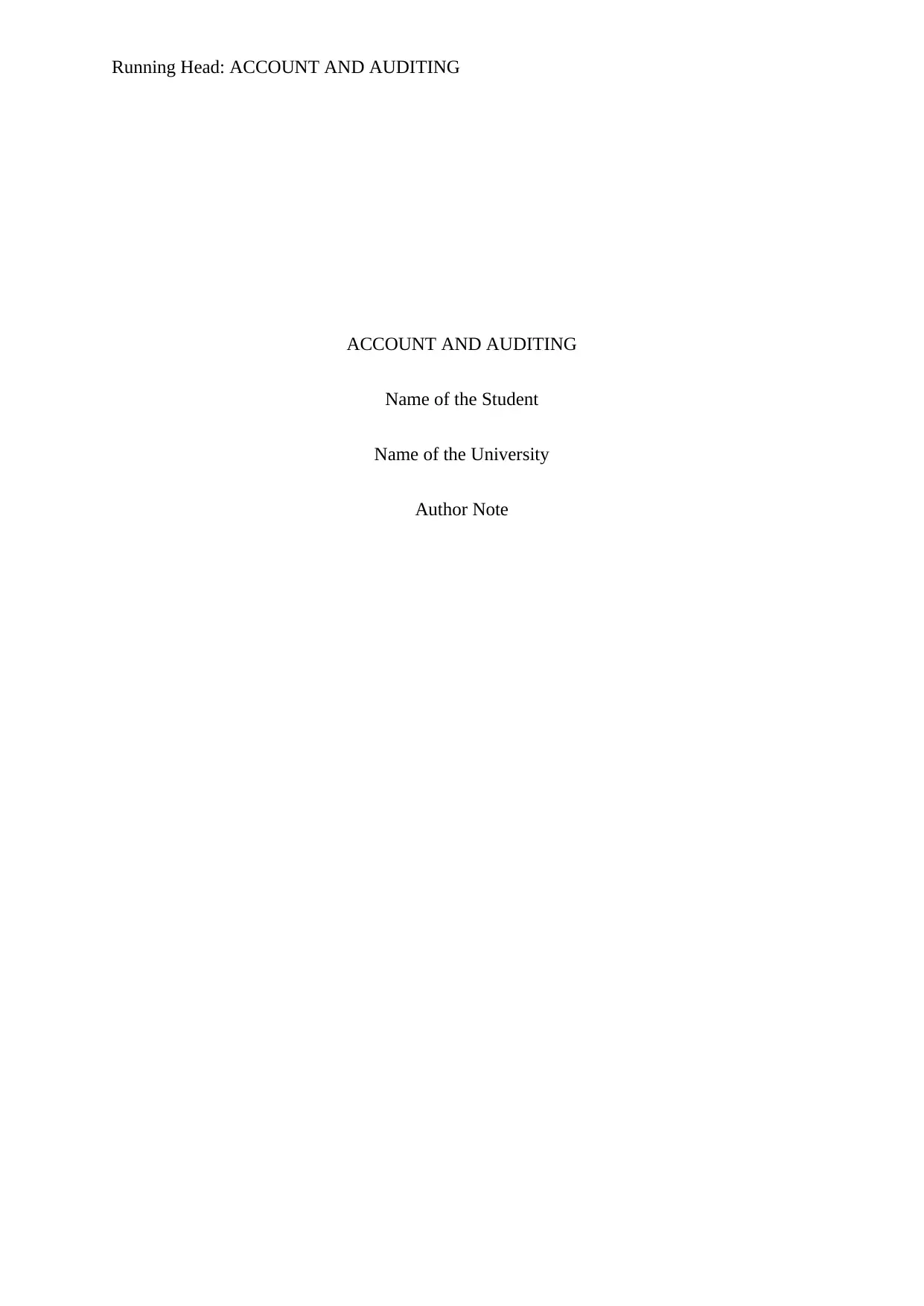
Running Head: ACCOUNT AND AUDITING
ACCOUNT AND AUDITING
Name of the Student
Name of the University
Author Note
ACCOUNT AND AUDITING
Name of the Student
Name of the University
Author Note
Paraphrase This Document
Need a fresh take? Get an instant paraphrase of this document with our AI Paraphraser
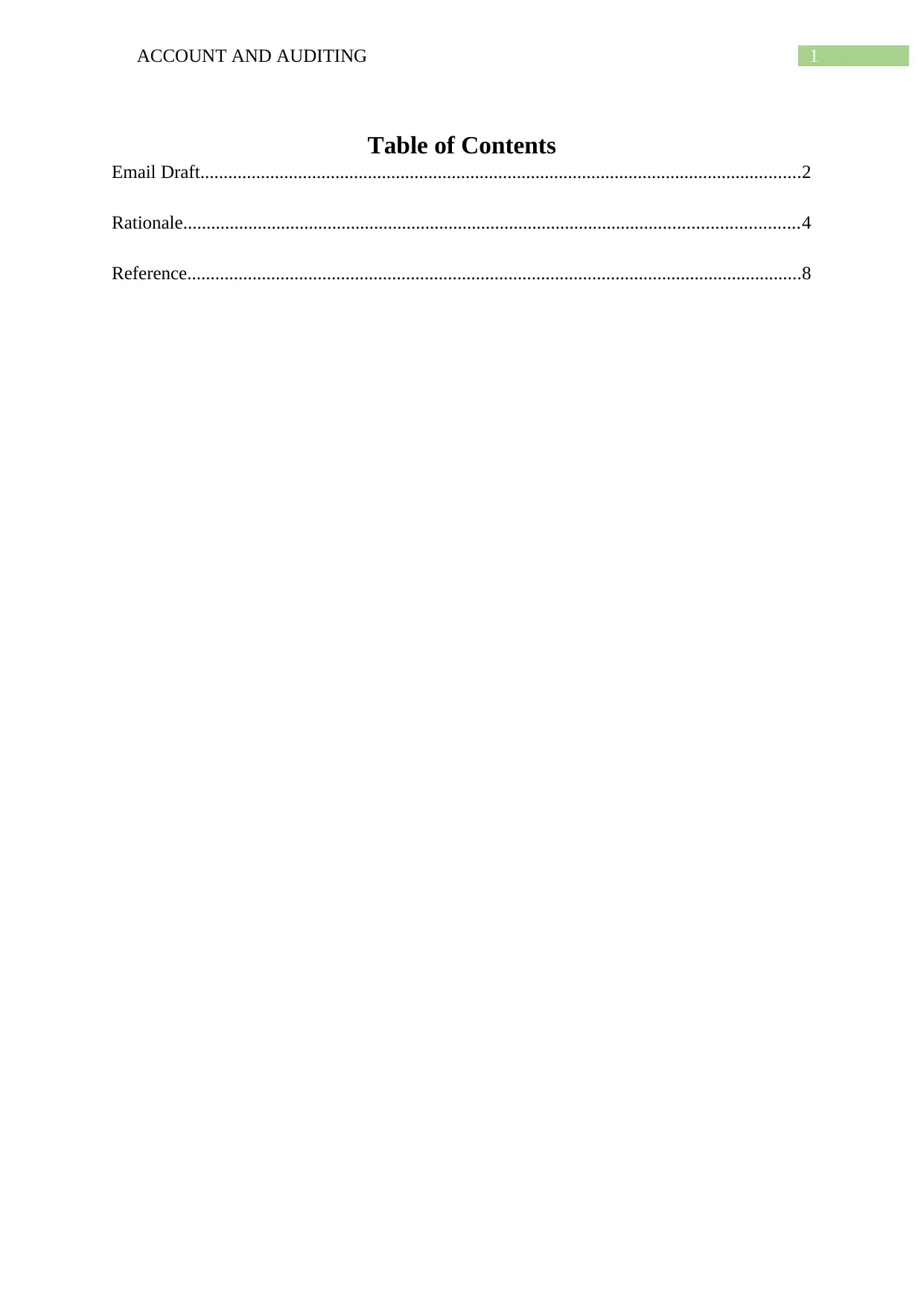
1ACCOUNT AND AUDITING
Table of Contents
Email Draft.................................................................................................................................2
Rationale....................................................................................................................................4
Reference....................................................................................................................................8
Table of Contents
Email Draft.................................................................................................................................2
Rationale....................................................................................................................................4
Reference....................................................................................................................................8
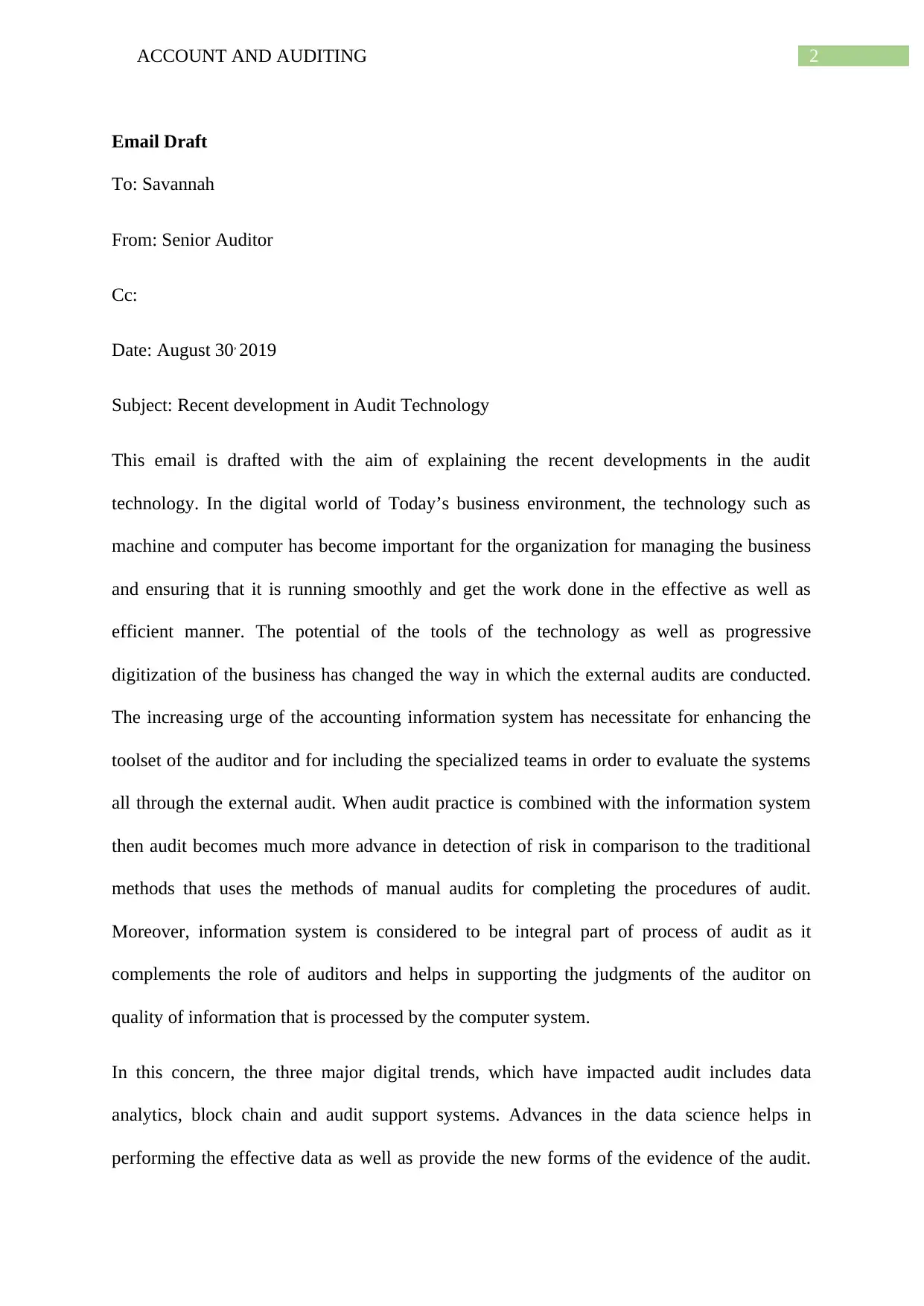
2ACCOUNT AND AUDITING
Email Draft
To: Savannah
From: Senior Auditor
Cc:
Date: August 30, 2019
Subject: Recent development in Audit Technology
This email is drafted with the aim of explaining the recent developments in the audit
technology. In the digital world of Today’s business environment, the technology such as
machine and computer has become important for the organization for managing the business
and ensuring that it is running smoothly and get the work done in the effective as well as
efficient manner. The potential of the tools of the technology as well as progressive
digitization of the business has changed the way in which the external audits are conducted.
The increasing urge of the accounting information system has necessitate for enhancing the
toolset of the auditor and for including the specialized teams in order to evaluate the systems
all through the external audit. When audit practice is combined with the information system
then audit becomes much more advance in detection of risk in comparison to the traditional
methods that uses the methods of manual audits for completing the procedures of audit.
Moreover, information system is considered to be integral part of process of audit as it
complements the role of auditors and helps in supporting the judgments of the auditor on
quality of information that is processed by the computer system.
In this concern, the three major digital trends, which have impacted audit includes data
analytics, block chain and audit support systems. Advances in the data science helps in
performing the effective data as well as provide the new forms of the evidence of the audit.
Email Draft
To: Savannah
From: Senior Auditor
Cc:
Date: August 30, 2019
Subject: Recent development in Audit Technology
This email is drafted with the aim of explaining the recent developments in the audit
technology. In the digital world of Today’s business environment, the technology such as
machine and computer has become important for the organization for managing the business
and ensuring that it is running smoothly and get the work done in the effective as well as
efficient manner. The potential of the tools of the technology as well as progressive
digitization of the business has changed the way in which the external audits are conducted.
The increasing urge of the accounting information system has necessitate for enhancing the
toolset of the auditor and for including the specialized teams in order to evaluate the systems
all through the external audit. When audit practice is combined with the information system
then audit becomes much more advance in detection of risk in comparison to the traditional
methods that uses the methods of manual audits for completing the procedures of audit.
Moreover, information system is considered to be integral part of process of audit as it
complements the role of auditors and helps in supporting the judgments of the auditor on
quality of information that is processed by the computer system.
In this concern, the three major digital trends, which have impacted audit includes data
analytics, block chain and audit support systems. Advances in the data science helps in
performing the effective data as well as provide the new forms of the evidence of the audit.
⊘ This is a preview!⊘
Do you want full access?
Subscribe today to unlock all pages.

Trusted by 1+ million students worldwide
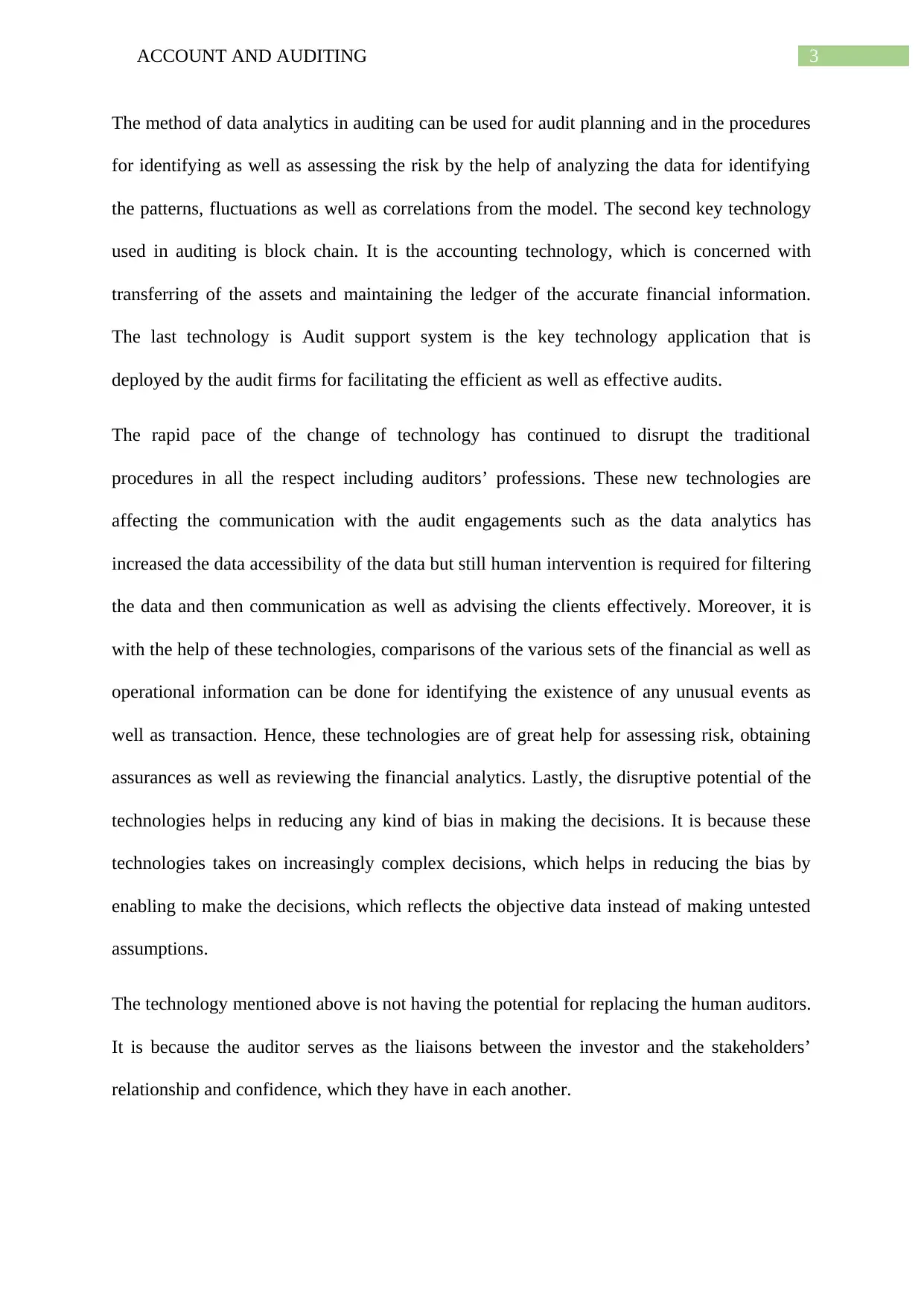
3ACCOUNT AND AUDITING
The method of data analytics in auditing can be used for audit planning and in the procedures
for identifying as well as assessing the risk by the help of analyzing the data for identifying
the patterns, fluctuations as well as correlations from the model. The second key technology
used in auditing is block chain. It is the accounting technology, which is concerned with
transferring of the assets and maintaining the ledger of the accurate financial information.
The last technology is Audit support system is the key technology application that is
deployed by the audit firms for facilitating the efficient as well as effective audits.
The rapid pace of the change of technology has continued to disrupt the traditional
procedures in all the respect including auditors’ professions. These new technologies are
affecting the communication with the audit engagements such as the data analytics has
increased the data accessibility of the data but still human intervention is required for filtering
the data and then communication as well as advising the clients effectively. Moreover, it is
with the help of these technologies, comparisons of the various sets of the financial as well as
operational information can be done for identifying the existence of any unusual events as
well as transaction. Hence, these technologies are of great help for assessing risk, obtaining
assurances as well as reviewing the financial analytics. Lastly, the disruptive potential of the
technologies helps in reducing any kind of bias in making the decisions. It is because these
technologies takes on increasingly complex decisions, which helps in reducing the bias by
enabling to make the decisions, which reflects the objective data instead of making untested
assumptions.
The technology mentioned above is not having the potential for replacing the human auditors.
It is because the auditor serves as the liaisons between the investor and the stakeholders’
relationship and confidence, which they have in each another.
The method of data analytics in auditing can be used for audit planning and in the procedures
for identifying as well as assessing the risk by the help of analyzing the data for identifying
the patterns, fluctuations as well as correlations from the model. The second key technology
used in auditing is block chain. It is the accounting technology, which is concerned with
transferring of the assets and maintaining the ledger of the accurate financial information.
The last technology is Audit support system is the key technology application that is
deployed by the audit firms for facilitating the efficient as well as effective audits.
The rapid pace of the change of technology has continued to disrupt the traditional
procedures in all the respect including auditors’ professions. These new technologies are
affecting the communication with the audit engagements such as the data analytics has
increased the data accessibility of the data but still human intervention is required for filtering
the data and then communication as well as advising the clients effectively. Moreover, it is
with the help of these technologies, comparisons of the various sets of the financial as well as
operational information can be done for identifying the existence of any unusual events as
well as transaction. Hence, these technologies are of great help for assessing risk, obtaining
assurances as well as reviewing the financial analytics. Lastly, the disruptive potential of the
technologies helps in reducing any kind of bias in making the decisions. It is because these
technologies takes on increasingly complex decisions, which helps in reducing the bias by
enabling to make the decisions, which reflects the objective data instead of making untested
assumptions.
The technology mentioned above is not having the potential for replacing the human auditors.
It is because the auditor serves as the liaisons between the investor and the stakeholders’
relationship and confidence, which they have in each another.
Paraphrase This Document
Need a fresh take? Get an instant paraphrase of this document with our AI Paraphraser
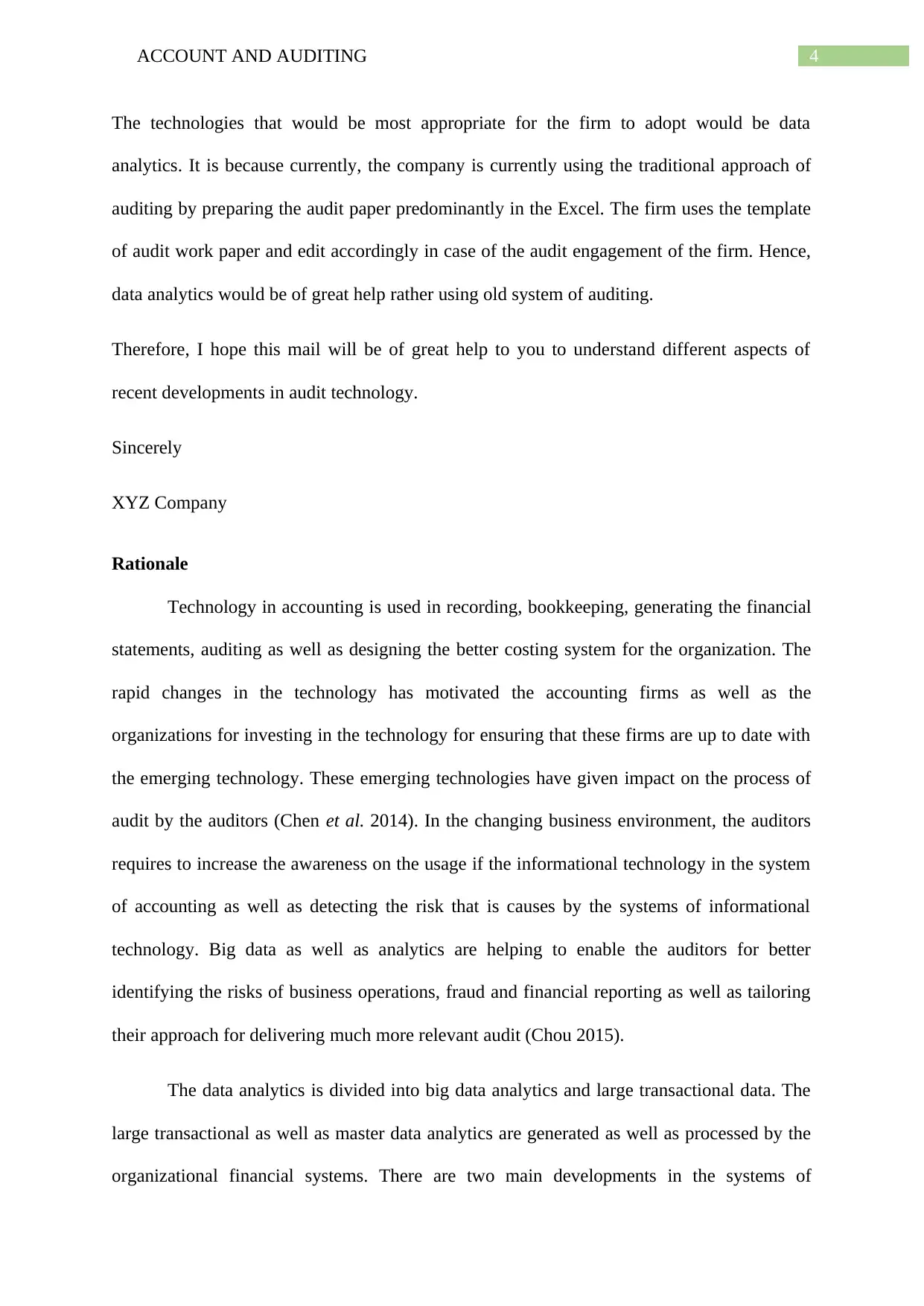
4ACCOUNT AND AUDITING
The technologies that would be most appropriate for the firm to adopt would be data
analytics. It is because currently, the company is currently using the traditional approach of
auditing by preparing the audit paper predominantly in the Excel. The firm uses the template
of audit work paper and edit accordingly in case of the audit engagement of the firm. Hence,
data analytics would be of great help rather using old system of auditing.
Therefore, I hope this mail will be of great help to you to understand different aspects of
recent developments in audit technology.
Sincerely
XYZ Company
Rationale
Technology in accounting is used in recording, bookkeeping, generating the financial
statements, auditing as well as designing the better costing system for the organization. The
rapid changes in the technology has motivated the accounting firms as well as the
organizations for investing in the technology for ensuring that these firms are up to date with
the emerging technology. These emerging technologies have given impact on the process of
audit by the auditors (Chen et al. 2014). In the changing business environment, the auditors
requires to increase the awareness on the usage if the informational technology in the system
of accounting as well as detecting the risk that is causes by the systems of informational
technology. Big data as well as analytics are helping to enable the auditors for better
identifying the risks of business operations, fraud and financial reporting as well as tailoring
their approach for delivering much more relevant audit (Chou 2015).
The data analytics is divided into big data analytics and large transactional data. The
large transactional as well as master data analytics are generated as well as processed by the
organizational financial systems. There are two main developments in the systems of
The technologies that would be most appropriate for the firm to adopt would be data
analytics. It is because currently, the company is currently using the traditional approach of
auditing by preparing the audit paper predominantly in the Excel. The firm uses the template
of audit work paper and edit accordingly in case of the audit engagement of the firm. Hence,
data analytics would be of great help rather using old system of auditing.
Therefore, I hope this mail will be of great help to you to understand different aspects of
recent developments in audit technology.
Sincerely
XYZ Company
Rationale
Technology in accounting is used in recording, bookkeeping, generating the financial
statements, auditing as well as designing the better costing system for the organization. The
rapid changes in the technology has motivated the accounting firms as well as the
organizations for investing in the technology for ensuring that these firms are up to date with
the emerging technology. These emerging technologies have given impact on the process of
audit by the auditors (Chen et al. 2014). In the changing business environment, the auditors
requires to increase the awareness on the usage if the informational technology in the system
of accounting as well as detecting the risk that is causes by the systems of informational
technology. Big data as well as analytics are helping to enable the auditors for better
identifying the risks of business operations, fraud and financial reporting as well as tailoring
their approach for delivering much more relevant audit (Chou 2015).
The data analytics is divided into big data analytics and large transactional data. The
large transactional as well as master data analytics are generated as well as processed by the
organizational financial systems. There are two main developments in the systems of
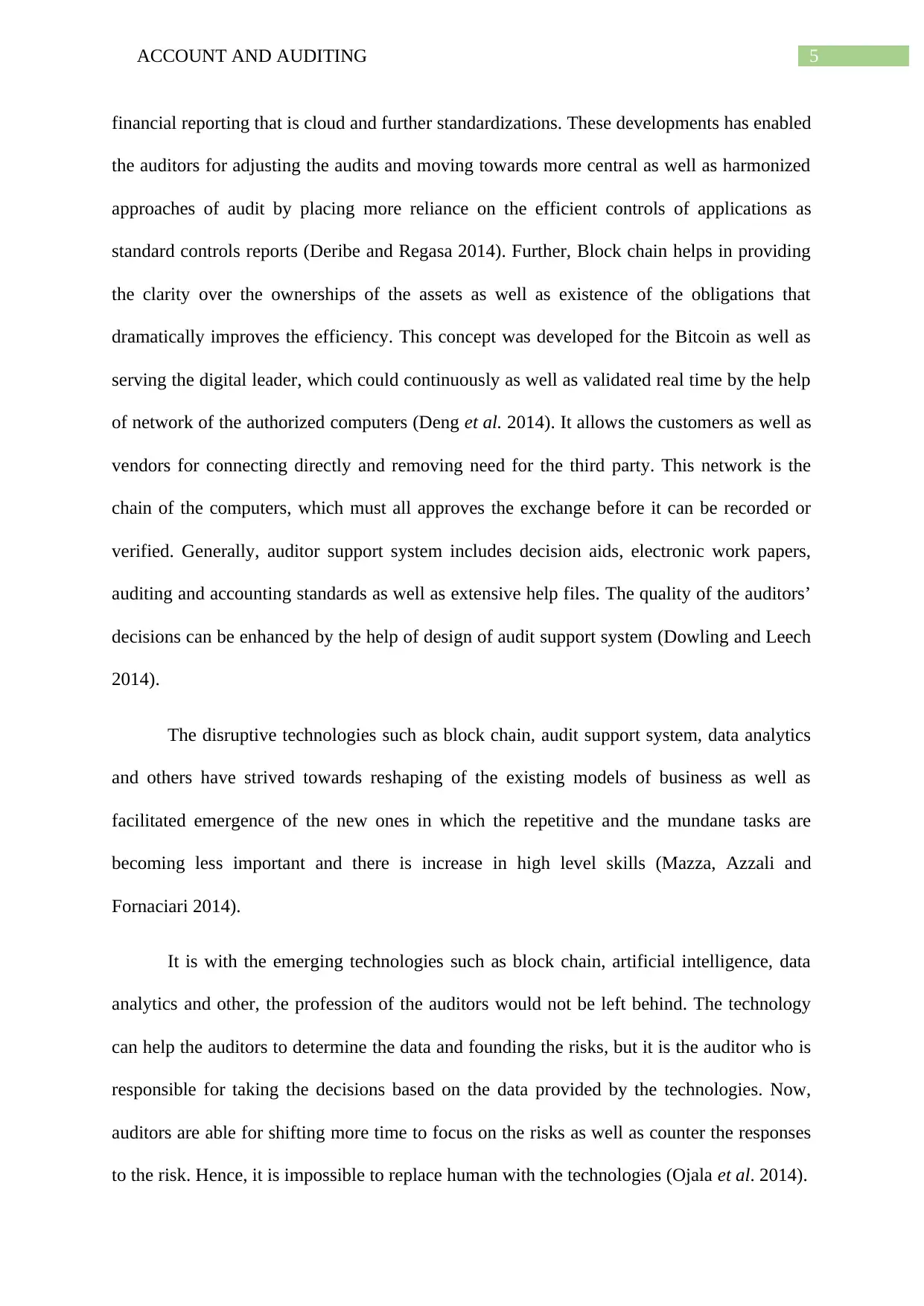
5ACCOUNT AND AUDITING
financial reporting that is cloud and further standardizations. These developments has enabled
the auditors for adjusting the audits and moving towards more central as well as harmonized
approaches of audit by placing more reliance on the efficient controls of applications as
standard controls reports (Deribe and Regasa 2014). Further, Block chain helps in providing
the clarity over the ownerships of the assets as well as existence of the obligations that
dramatically improves the efficiency. This concept was developed for the Bitcoin as well as
serving the digital leader, which could continuously as well as validated real time by the help
of network of the authorized computers (Deng et al. 2014). It allows the customers as well as
vendors for connecting directly and removing need for the third party. This network is the
chain of the computers, which must all approves the exchange before it can be recorded or
verified. Generally, auditor support system includes decision aids, electronic work papers,
auditing and accounting standards as well as extensive help files. The quality of the auditors’
decisions can be enhanced by the help of design of audit support system (Dowling and Leech
2014).
The disruptive technologies such as block chain, audit support system, data analytics
and others have strived towards reshaping of the existing models of business as well as
facilitated emergence of the new ones in which the repetitive and the mundane tasks are
becoming less important and there is increase in high level skills (Mazza, Azzali and
Fornaciari 2014).
It is with the emerging technologies such as block chain, artificial intelligence, data
analytics and other, the profession of the auditors would not be left behind. The technology
can help the auditors to determine the data and founding the risks, but it is the auditor who is
responsible for taking the decisions based on the data provided by the technologies. Now,
auditors are able for shifting more time to focus on the risks as well as counter the responses
to the risk. Hence, it is impossible to replace human with the technologies (Ojala et al. 2014).
financial reporting that is cloud and further standardizations. These developments has enabled
the auditors for adjusting the audits and moving towards more central as well as harmonized
approaches of audit by placing more reliance on the efficient controls of applications as
standard controls reports (Deribe and Regasa 2014). Further, Block chain helps in providing
the clarity over the ownerships of the assets as well as existence of the obligations that
dramatically improves the efficiency. This concept was developed for the Bitcoin as well as
serving the digital leader, which could continuously as well as validated real time by the help
of network of the authorized computers (Deng et al. 2014). It allows the customers as well as
vendors for connecting directly and removing need for the third party. This network is the
chain of the computers, which must all approves the exchange before it can be recorded or
verified. Generally, auditor support system includes decision aids, electronic work papers,
auditing and accounting standards as well as extensive help files. The quality of the auditors’
decisions can be enhanced by the help of design of audit support system (Dowling and Leech
2014).
The disruptive technologies such as block chain, audit support system, data analytics
and others have strived towards reshaping of the existing models of business as well as
facilitated emergence of the new ones in which the repetitive and the mundane tasks are
becoming less important and there is increase in high level skills (Mazza, Azzali and
Fornaciari 2014).
It is with the emerging technologies such as block chain, artificial intelligence, data
analytics and other, the profession of the auditors would not be left behind. The technology
can help the auditors to determine the data and founding the risks, but it is the auditor who is
responsible for taking the decisions based on the data provided by the technologies. Now,
auditors are able for shifting more time to focus on the risks as well as counter the responses
to the risk. Hence, it is impossible to replace human with the technologies (Ojala et al. 2014).
⊘ This is a preview!⊘
Do you want full access?
Subscribe today to unlock all pages.

Trusted by 1+ million students worldwide
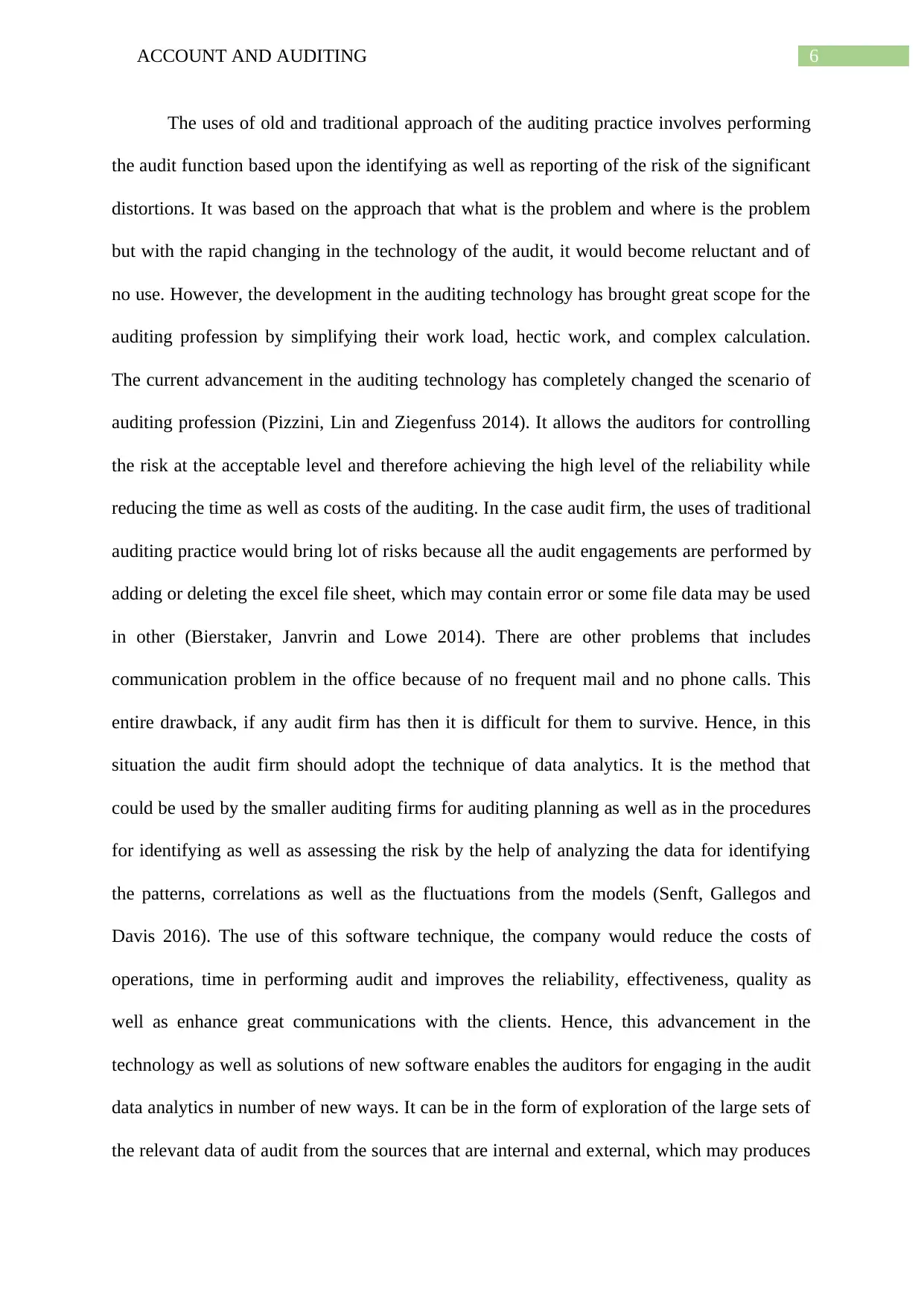
6ACCOUNT AND AUDITING
The uses of old and traditional approach of the auditing practice involves performing
the audit function based upon the identifying as well as reporting of the risk of the significant
distortions. It was based on the approach that what is the problem and where is the problem
but with the rapid changing in the technology of the audit, it would become reluctant and of
no use. However, the development in the auditing technology has brought great scope for the
auditing profession by simplifying their work load, hectic work, and complex calculation.
The current advancement in the auditing technology has completely changed the scenario of
auditing profession (Pizzini, Lin and Ziegenfuss 2014). It allows the auditors for controlling
the risk at the acceptable level and therefore achieving the high level of the reliability while
reducing the time as well as costs of the auditing. In the case audit firm, the uses of traditional
auditing practice would bring lot of risks because all the audit engagements are performed by
adding or deleting the excel file sheet, which may contain error or some file data may be used
in other (Bierstaker, Janvrin and Lowe 2014). There are other problems that includes
communication problem in the office because of no frequent mail and no phone calls. This
entire drawback, if any audit firm has then it is difficult for them to survive. Hence, in this
situation the audit firm should adopt the technique of data analytics. It is the method that
could be used by the smaller auditing firms for auditing planning as well as in the procedures
for identifying as well as assessing the risk by the help of analyzing the data for identifying
the patterns, correlations as well as the fluctuations from the models (Senft, Gallegos and
Davis 2016). The use of this software technique, the company would reduce the costs of
operations, time in performing audit and improves the reliability, effectiveness, quality as
well as enhance great communications with the clients. Hence, this advancement in the
technology as well as solutions of new software enables the auditors for engaging in the audit
data analytics in number of new ways. It can be in the form of exploration of the large sets of
the relevant data of audit from the sources that are internal and external, which may produces
The uses of old and traditional approach of the auditing practice involves performing
the audit function based upon the identifying as well as reporting of the risk of the significant
distortions. It was based on the approach that what is the problem and where is the problem
but with the rapid changing in the technology of the audit, it would become reluctant and of
no use. However, the development in the auditing technology has brought great scope for the
auditing profession by simplifying their work load, hectic work, and complex calculation.
The current advancement in the auditing technology has completely changed the scenario of
auditing profession (Pizzini, Lin and Ziegenfuss 2014). It allows the auditors for controlling
the risk at the acceptable level and therefore achieving the high level of the reliability while
reducing the time as well as costs of the auditing. In the case audit firm, the uses of traditional
auditing practice would bring lot of risks because all the audit engagements are performed by
adding or deleting the excel file sheet, which may contain error or some file data may be used
in other (Bierstaker, Janvrin and Lowe 2014). There are other problems that includes
communication problem in the office because of no frequent mail and no phone calls. This
entire drawback, if any audit firm has then it is difficult for them to survive. Hence, in this
situation the audit firm should adopt the technique of data analytics. It is the method that
could be used by the smaller auditing firms for auditing planning as well as in the procedures
for identifying as well as assessing the risk by the help of analyzing the data for identifying
the patterns, correlations as well as the fluctuations from the models (Senft, Gallegos and
Davis 2016). The use of this software technique, the company would reduce the costs of
operations, time in performing audit and improves the reliability, effectiveness, quality as
well as enhance great communications with the clients. Hence, this advancement in the
technology as well as solutions of new software enables the auditors for engaging in the audit
data analytics in number of new ways. It can be in the form of exploration of the large sets of
the relevant data of audit from the sources that are internal and external, which may produces
Paraphrase This Document
Need a fresh take? Get an instant paraphrase of this document with our AI Paraphraser
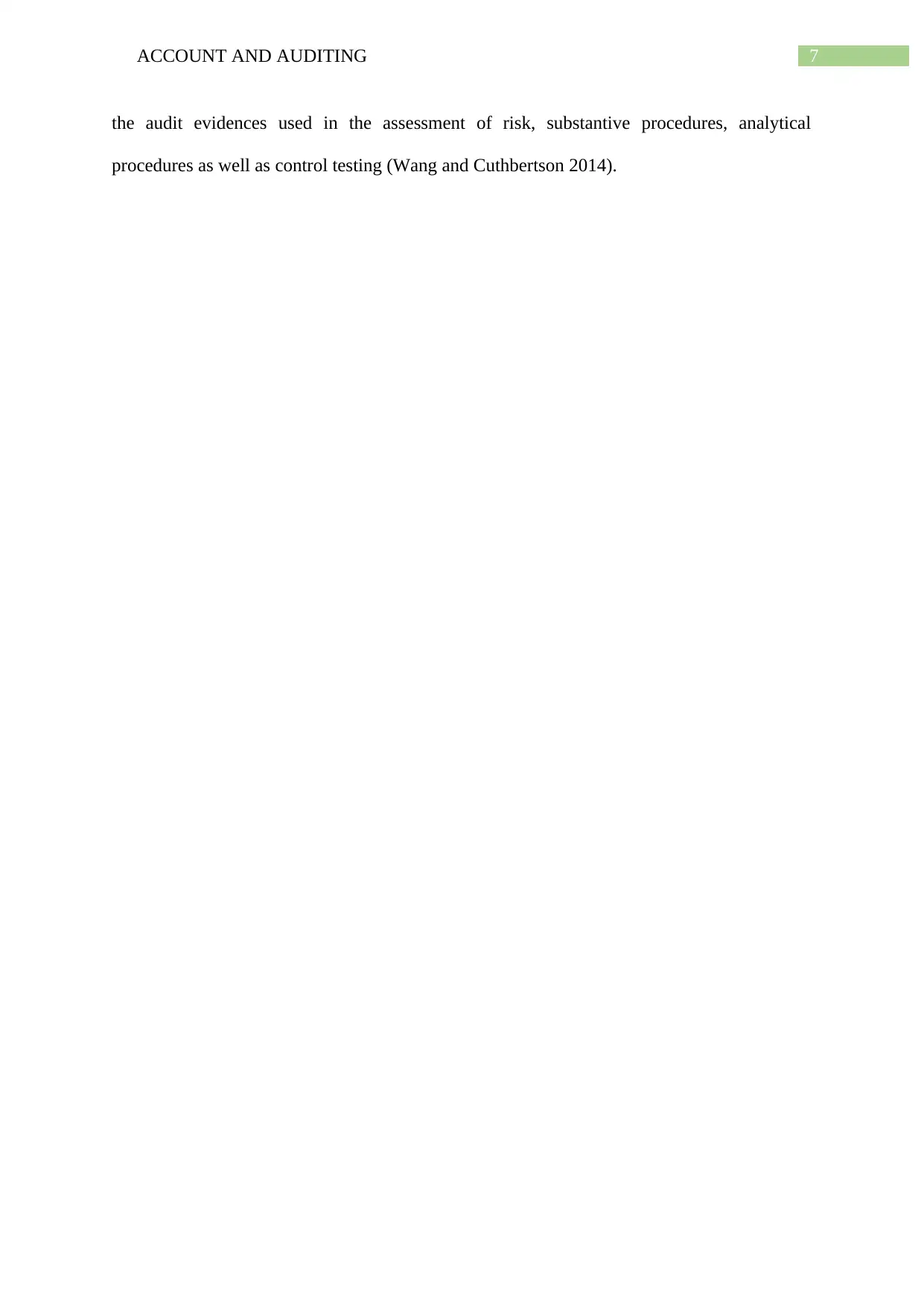
7ACCOUNT AND AUDITING
the audit evidences used in the assessment of risk, substantive procedures, analytical
procedures as well as control testing (Wang and Cuthbertson 2014).
the audit evidences used in the assessment of risk, substantive procedures, analytical
procedures as well as control testing (Wang and Cuthbertson 2014).
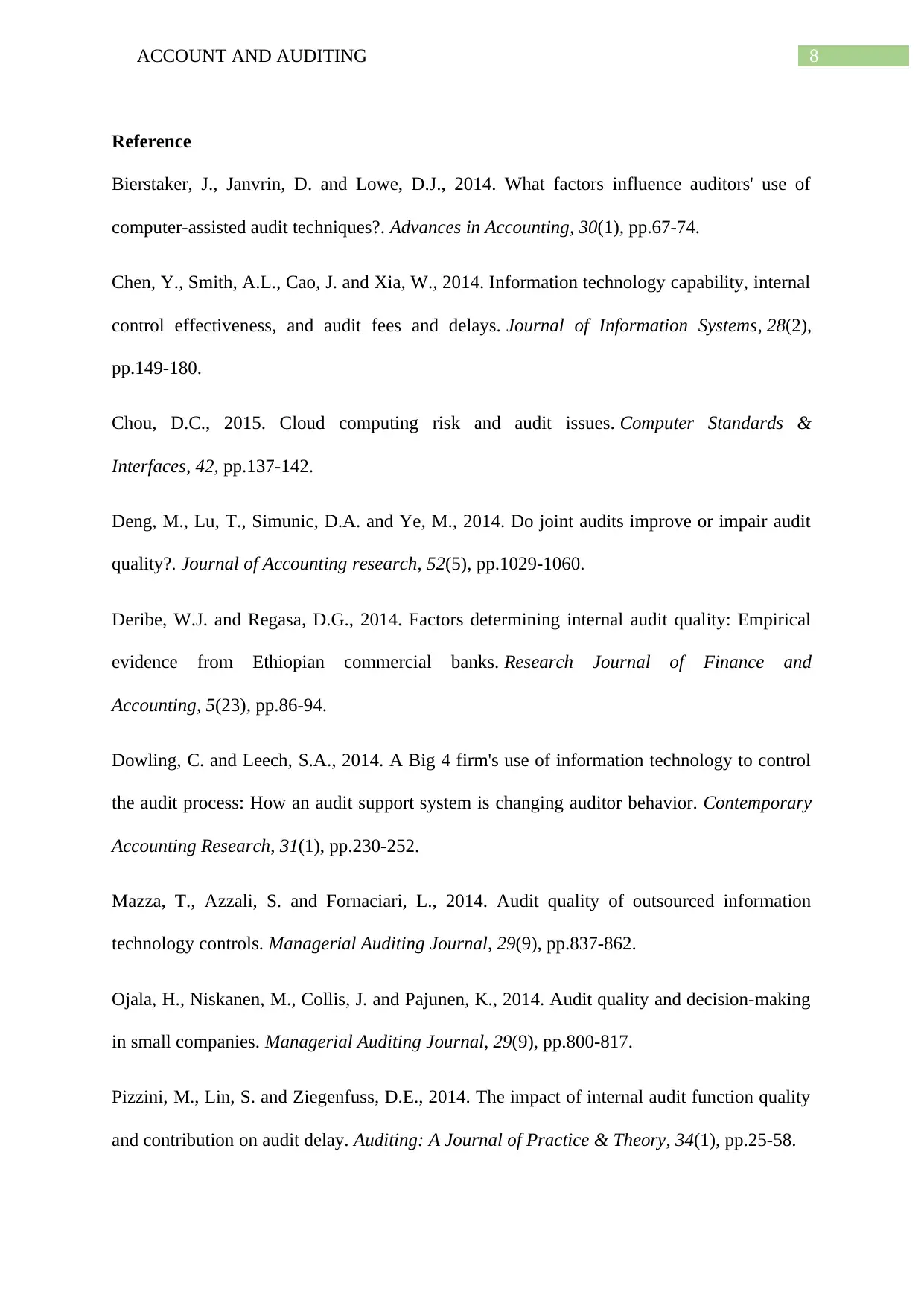
8ACCOUNT AND AUDITING
Reference
Bierstaker, J., Janvrin, D. and Lowe, D.J., 2014. What factors influence auditors' use of
computer-assisted audit techniques?. Advances in Accounting, 30(1), pp.67-74.
Chen, Y., Smith, A.L., Cao, J. and Xia, W., 2014. Information technology capability, internal
control effectiveness, and audit fees and delays. Journal of Information Systems, 28(2),
pp.149-180.
Chou, D.C., 2015. Cloud computing risk and audit issues. Computer Standards &
Interfaces, 42, pp.137-142.
Deng, M., Lu, T., Simunic, D.A. and Ye, M., 2014. Do joint audits improve or impair audit
quality?. Journal of Accounting research, 52(5), pp.1029-1060.
Deribe, W.J. and Regasa, D.G., 2014. Factors determining internal audit quality: Empirical
evidence from Ethiopian commercial banks. Research Journal of Finance and
Accounting, 5(23), pp.86-94.
Dowling, C. and Leech, S.A., 2014. A Big 4 firm's use of information technology to control
the audit process: How an audit support system is changing auditor behavior. Contemporary
Accounting Research, 31(1), pp.230-252.
Mazza, T., Azzali, S. and Fornaciari, L., 2014. Audit quality of outsourced information
technology controls. Managerial Auditing Journal, 29(9), pp.837-862.
Ojala, H., Niskanen, M., Collis, J. and Pajunen, K., 2014. Audit quality and decision-making
in small companies. Managerial Auditing Journal, 29(9), pp.800-817.
Pizzini, M., Lin, S. and Ziegenfuss, D.E., 2014. The impact of internal audit function quality
and contribution on audit delay. Auditing: A Journal of Practice & Theory, 34(1), pp.25-58.
Reference
Bierstaker, J., Janvrin, D. and Lowe, D.J., 2014. What factors influence auditors' use of
computer-assisted audit techniques?. Advances in Accounting, 30(1), pp.67-74.
Chen, Y., Smith, A.L., Cao, J. and Xia, W., 2014. Information technology capability, internal
control effectiveness, and audit fees and delays. Journal of Information Systems, 28(2),
pp.149-180.
Chou, D.C., 2015. Cloud computing risk and audit issues. Computer Standards &
Interfaces, 42, pp.137-142.
Deng, M., Lu, T., Simunic, D.A. and Ye, M., 2014. Do joint audits improve or impair audit
quality?. Journal of Accounting research, 52(5), pp.1029-1060.
Deribe, W.J. and Regasa, D.G., 2014. Factors determining internal audit quality: Empirical
evidence from Ethiopian commercial banks. Research Journal of Finance and
Accounting, 5(23), pp.86-94.
Dowling, C. and Leech, S.A., 2014. A Big 4 firm's use of information technology to control
the audit process: How an audit support system is changing auditor behavior. Contemporary
Accounting Research, 31(1), pp.230-252.
Mazza, T., Azzali, S. and Fornaciari, L., 2014. Audit quality of outsourced information
technology controls. Managerial Auditing Journal, 29(9), pp.837-862.
Ojala, H., Niskanen, M., Collis, J. and Pajunen, K., 2014. Audit quality and decision-making
in small companies. Managerial Auditing Journal, 29(9), pp.800-817.
Pizzini, M., Lin, S. and Ziegenfuss, D.E., 2014. The impact of internal audit function quality
and contribution on audit delay. Auditing: A Journal of Practice & Theory, 34(1), pp.25-58.
⊘ This is a preview!⊘
Do you want full access?
Subscribe today to unlock all pages.

Trusted by 1+ million students worldwide
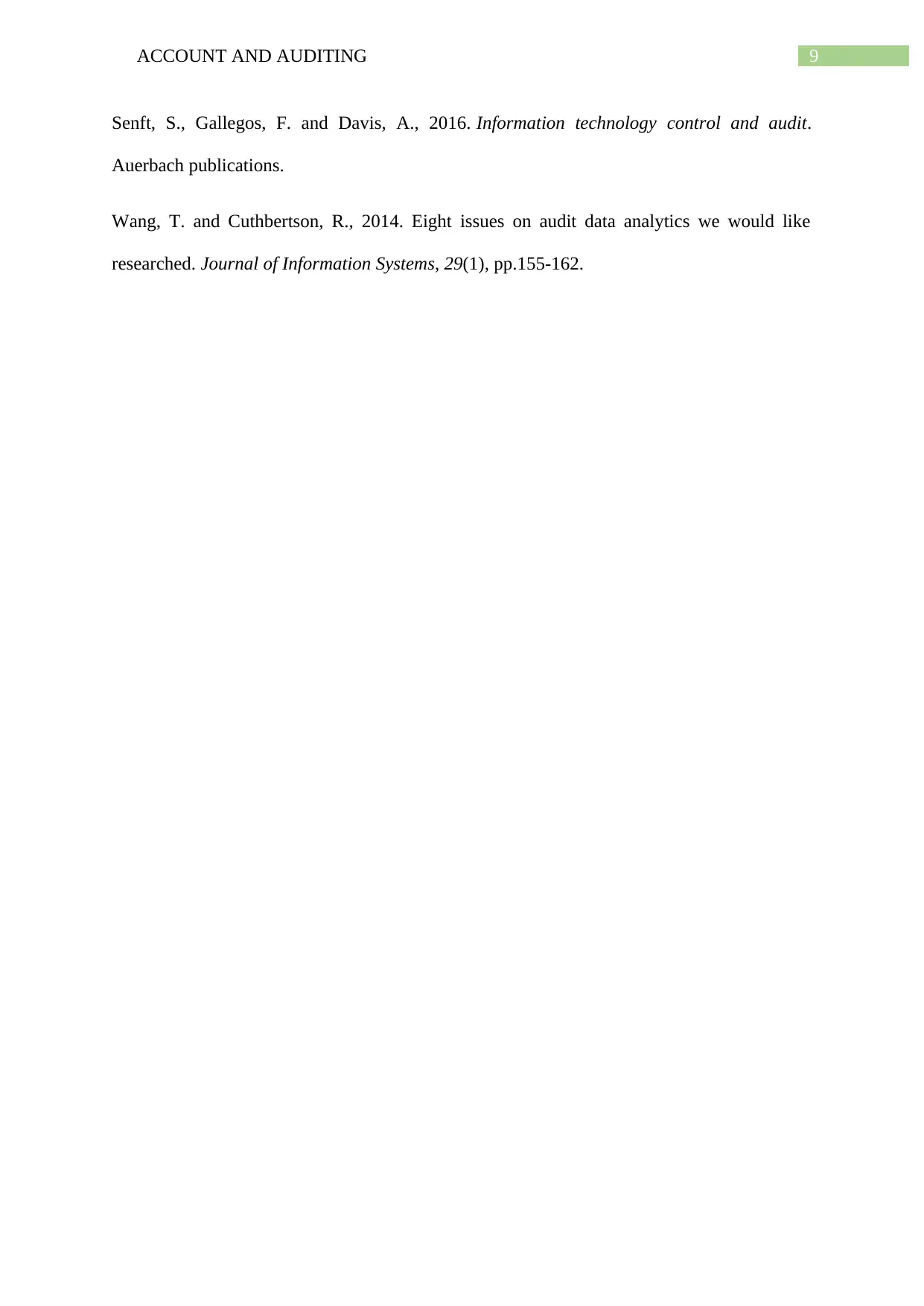
9ACCOUNT AND AUDITING
Senft, S., Gallegos, F. and Davis, A., 2016. Information technology control and audit.
Auerbach publications.
Wang, T. and Cuthbertson, R., 2014. Eight issues on audit data analytics we would like
researched. Journal of Information Systems, 29(1), pp.155-162.
Senft, S., Gallegos, F. and Davis, A., 2016. Information technology control and audit.
Auerbach publications.
Wang, T. and Cuthbertson, R., 2014. Eight issues on audit data analytics we would like
researched. Journal of Information Systems, 29(1), pp.155-162.
1 out of 10
Related Documents
Your All-in-One AI-Powered Toolkit for Academic Success.
+13062052269
info@desklib.com
Available 24*7 on WhatsApp / Email
![[object Object]](/_next/static/media/star-bottom.7253800d.svg)
Unlock your academic potential
Copyright © 2020–2025 A2Z Services. All Rights Reserved. Developed and managed by ZUCOL.





